Culture, Carnival and the strangeness of HG
My school recently hosted their annual Culture Day. Over the last two weeks, the students had spent their afternoon hours busily compiling and creating a variety of exhibitions, entertainment and interactive experiments for the community to enjoy. They were the theoretical busy bees.
This being my second year living on the island, I was a little more prepared for what the high school students were hoping to include in their Culture Day. Last year, I had prepared a CD of popular American music and corresponding information on the artists -- taking great pains to show a wide variety of styles and influences. I remember being quite proud of my work --thinking I had shed some light on such a big component of US culture. I can humbly report to you that my exhibit had less than a luke warm reception. It was more confusing than anything. Students, and teachers alike regarded it with curiosity and pity.
Take a moment and think about your image of Japanese culture. What would you expect to see at a Japanese high school Culture Day? You might be thinking exhibitions about geishas wearing kimono, poets sitting in zen gardens, writing haiku, or even the bloody marauding of the samurai. I was guilty of expecting traditional Japan last year, and in reality, I got a good healthy dose of what can only be considered pop-culture.
The Culture Day is more of a mix between a craft fair and carnival, and is relatively far removed from examining culture. Each classroom agrees upon a theme, activity or craft and work together to attain their goals. (Students are also trying to generate funds for their class and can charge admission to their room or sell their wears.) The school is open to the community and there's even a make-shift cafeteria set up where udon and curry-rice is sold. There's usually a high turn-out of elementary school students.
This year, among the rooms, there was a haunted house, a flea market and several rooms selling tickets for the chance to sit in a folding chair and watch a DVD. A few of the classrooms went a more artistic route and constructed quaint country-esque signs that would fit in nicely at a B&B, and painted pictures. Here are some shots of the day....
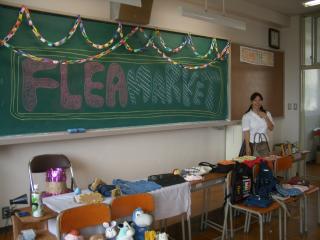 Here's the 3rd year student's Flea Market.
Here's the 3rd year student's Flea Market.
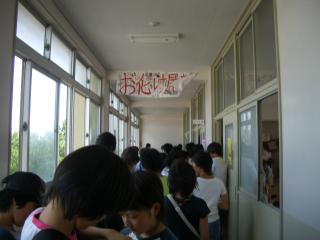 Here's the line outside of the 2nd year student's haunted house.
Here's the line outside of the 2nd year student's haunted house.
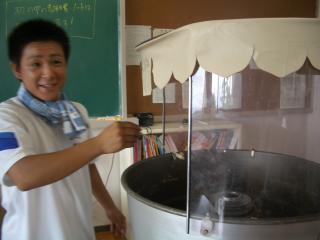 Here's Ebisu-kun, a 3rd year student, who was in charge of selling cotton candy.
Here's Ebisu-kun, a 3rd year student, who was in charge of selling cotton candy.
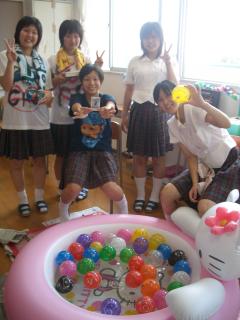 Some of the 3rd year students selling balloon Yo-Yos as a part of their Flea Market.
Some of the 3rd year students selling balloon Yo-Yos as a part of their Flea Market.
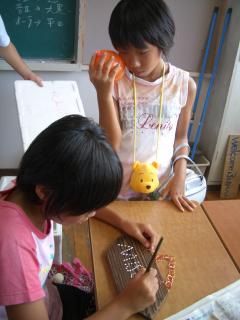
Here, and elementary school student paints her name on one of the signs that were made by a 2nd year classroom.
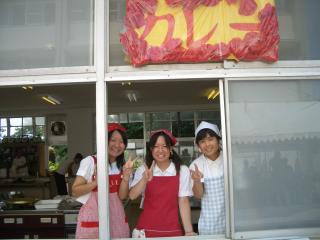
1st year students, selling curry-rice from the cooking room.
After the day had come to a close, and the school returned to its normalcy, the teachers gathered at one of the local watering holes to celebrate the hard work done. During this enkai, I was privy to lose lips and some frustrations. A little surprised, I listened to one of the math teachers explain how flea markets and haunted houses had nothing to do with culture, and the students who actually created some kind of art had a better understanding of culture.
This is what his class produced....
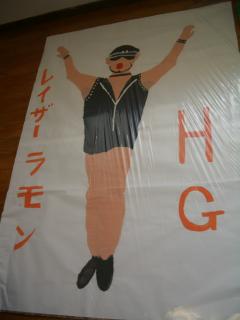
Now, this actually is an interesting production of Japanese pop culture in my opinion. Said math teacher asked his students to paint pictures. Now, of course, art is easily considered culture in any community. Moreover, I find it wildly interesting that this is what the kids actually produced. The writing at the left says REIZA- RAMON and I was told that HG stands for Hard Gay. This was shocking enough, but the fact that a different classroom had similar life-sized paintings with the faces cut out so that anyone could slip on the HG persona for a Polaroid snapshot was beyond comprehension. (That homeroom teacher shared her shock with me later that night and said that she had been kept from seeing the posters until the day of the festival.)
Now HG didn't just pop out of some kind of repressed and forbidden students homophobia. Apparently, there is a HG character out there, somewhere, running around on the TV and is teaching the youth of Japan that this person, this image, is one of ridiculous humor. I haven't seen him in action, but have been tuning in more and more, hoping to get a glimpse of how homosexuality is played out on prime time television in Japan. I'd also like to learn about this character as a means of opening up communication on the taboo subject. I find myself saying "Well, in the US, this and that, or such and such is or is not accepted." It's a constant refrain.
The day was a success in the fact that every class participated and worked together to entertain the community. I have a very different image of what a "Culture Day" would be in the US and I have a very hard time answering when someone asks if I followed the same customs when I was a student. I want to tell them yes; that my schools participated in carnivals and bake sales to generate money; that we made crafts and displayed them; and that we even participated in Culture Days, but that those days consisted of very different things than their all encompassing day of celebration.


3 Comments:
CULTURE DAY! SWEEEET! So different that here. haha GAY!
you gotta update this more! I'm interested!
Steve
2 months since update...not right...so wrong...
Post a Comment
<< Home